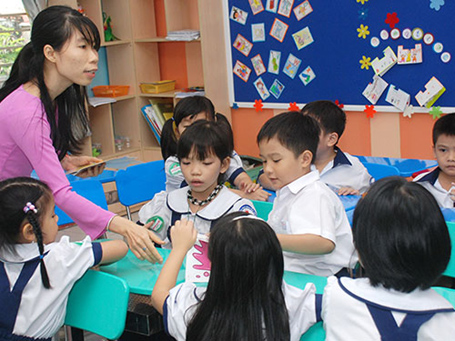While a regulation on education quality verification has taken effect since January 6, many schools in HCM City said it’s unpractical and improper.

Nguyen Van Troi Primary School will be subject to the verification this year
The Ministry of Education and Training (MoET)’s Circular 42 is meant to guarantee education quality at basic and continuing education institutions nationwide.
Under the regulation, schools across the country will be verified based on new criteria set for school management, teacher quality, class sizes, school infrastructure and study facilities, cooperation with families and community and education results.
The new regulation stipulates 35 as the maximum number of students per class for primary education, at 45 for secondary and high school education.
Schools in the inner city must have at least six square metres per student and those in the outskirts must have 10 square metres per student.
Difficult to meet new requirements
In mid-December 2012, the HCM City municipal Department of Education and Training announced a list of 91 schools ranging from preschools to high schools that were to be subject to the verification system. However, the list did not include any schools in District 1.
The leader of a secondary school in the district said that none of the schools in District 1 were able to meet the requirements pertaining to class size and area.
“The number of students has been sharply increasing in recent years while the school’s area has stayed the same,” he noted.
Even many schools well known for their high quality of education fail to meet the new requirements, because they lack space, such as playgrounds for students.
In District 4, Khanh Hoi A Secondary School met the new standards at level 2 in 2012, but failed to meet the standards at level 3.
Nguyen Van Troi Primary School is one of the schools that will be subject to the verification system this year. But the school’s principle Pham Thuy Ha said, “Whether or not a school meets these specific requirements, the focus should be on the quality of education a school provides. As a matter of fact, if a school provides good-quality education, they are likely to attract a large number of student."
Ha Thanh Hai, Principle of Luong The Vinh Primary School, said, “Our school can meet new requirements for qualified teachers and infrastructure but the number of students per class is much higher than the requirement. We don’t want to force students to move to other schools just simply to meet the criteria.”
This year, five schools in District 5 will be subject to the verification system and most of them have already been recognised as a national-standardised school.
However, Vo Ngoc Thu, head of the district Office for Education and Training, said these five schools would easily be able to meet the new requirements, especially the criteria on the number of students in a class. Still, the number of students could become much higher in the next few years.
Meanwhile, some schools that previously met the standards now fail due to unexpected reasons. Nguyen Thuong Hien High School is an example.
The school was the first institution in HCM City that met all criteria on education quality, teaching programmes, infrastructure and development strategies. However, in the latest enrollment season, the school was compelled to accept nearly 40 applicants who had the same marks on their entrance exams, driving up the number of students in a class.
Time needed
Dr. Nguyen Kim Dung. from the HCM City Education Research Institute said, “It would take at least two months to take good measure of the feasibility of the regulation and two years to assess its efficiency. However, I’m sure that the regulation is the best criteria for verifying education quality issued by the MoET so far.”
The institute is working in coordination with the HCM City Department of Education and Training to choose four schools for a pilot verification programme. Selected schools would include different types: state, non-state, high and medium-quality institutions, Dung added.

Leave your comment on this story